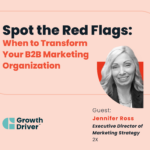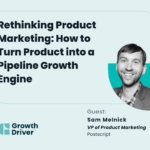With constant new tools, channels, and strategies, you’d think marketers would be doing better than ever. Before ABX and near-bound, it was social, mobile, and content. It’s easy to assume because of all the new amazing technology and methodologies it’s easy to make pipeline numbers all the time, but that’s not the case.
The old growth playbook tended to be very acquisition focused, leaving marketing over-prioritized on pipeline generation. Now, buyers have rotated towards being more anonymous. Organizations have lost visibility with new data privacy regulations. And with the end of the zero interest rate era, efficiency has never been more critical.
We sat down with Jon Miller, MarTech entrepreneur and former Marketo founder, for a rigorous analysis of what changes are driving the need for a new B2B growth playbook.
Critical Changes Fueling the Need for a New B2B Playbook
1. Content is changing.
Buyer’s shift to online anonymity has driven a fundamental disconnect in the way companies approach go-to-market. Gated content isn’t seen to be valuable anymore. The content itself may be, but executives would rather avoid the flood of unwanted spam and find that information elsewhere.
As Jon Miller says in episode 7, “Do you think your buyers decide to not learn? They go learn from someone else if they’re not learning from you. If they’re not developing buying preferences, they’re developing those preferences somewhere else.”
The Solution: Executives are looking for proprietary insights and research that only your company can provide. Move away from gated, long form content, and towards building audience communities. Think about how to mine unique insights and data to produce content or research that no one else can.
2. B2B growth is a team sport.
Most companies have come to understand that plans and strategies that are created in siloes will be less effective than those that are collaborative cross-functionally. The sixth pillar of the new playbook highlights the importance of clarifying roles sales and marketing play, and how they can better support each other.
In the B2B growth industry we’ve been trained to separate sales and marketing sourced metrics. But the buying process is complex, and using attribution to assign credit to sales can erode team culture.
The Solution: Adopt a team-based-metrics approach. Co-host of Growth Driver and Intelligent Demand CEO John Common described this as, “Use your metrics reporting and attribution to improve your go to market motions, not to prove the value of your left leg versus your right leg.”
3. Data has changed.
Privacy changes and lost visibility with increasing buyer indifference have impacted intent data accuracy. The old playbook relied heavily on first party data, purchased lists, and disconnected data sets. We don’t know who is engaging with our websites or what they’re doing.
But as Jon Miller points out, “companies don’t have a right to privacy. People do.” Big data and machine learning have made it possible to aggregate what’s happening on the open web at the company level and use that to create insights and signals.
The Solution: Aggregate data at the company level to create insights and signals for accurate account-level intent. When there are spikes in intent data, you’ll know the account is actually moving into the 5% of the market ready and wanting to buy.
4. The pivot to efficient growth.
When money was cheap, we were in a phase of “growth at all costs.” We know that all 100% of the market is likely not ICP-fit, and only a small percent is actually ready or considering buying. But the old playbook trained marketers to try and touch everyone.
New playbook challenges this way of thinking, largely motivated by limited resources and the need to make those investments as efficient as possible. As Jon Miller summarizes, “The whole idea is when you have fewer dollars and fewer resources, you’ve got to re-focus them better on the ones that are going to have that highest, highest impact.”
The Solution: Focus on the 5% of the market that is actually in intent buying stages and allocate resources accordingly. Remember, volume doesn’t matter if it’s not specified to buyers with actual potential of buying within your ICP. Go after accounts that are interested in buying AND interested in your company.
The Mandate for Efficient Growth
Old playbook tactics have simply lost their punch. But with so much of the old playbook foundation being based on outdated capabilities and trends, it’s not shocking the way we approach B2B growth needs an overhaul.
Expert partners have proven to be a critical and invaluable resource for companies pivoting to efficient, modern growth plays. Schedule time to talk with our leading growth consultants to explore the possibilities at your organization.
About Growth Driver Guest Jon Miller
Jon Miller is a real deal marketing technology entrepreneur, executive, and thought Leader. He’s played a pivotal role in category creation in this sector, and as the former CMO of Demandbase, Jon revolutionized B2B go-to-market strategies. He also co-founded Marketo, a leading marketing automation platform, and was integral in its IPO success. Jon was also the CEO and founder of Engagio, which merged with Demandbase.
Jon sat down with us on Growth Driver to do a point-by-point analysis that compares and contrasts the old playbook and the new playbook for B2B growth.
Key Moments from this Episode:
In B2B Growth: New Playbook vs. Old Playbook with Jon Miller, we honed in on eight key pillars of the new B2B playbook organizations can leverage to reach their growth goals in 2024.
03:22 – The Three Disconnects Between Marketers and GTM
09:29 – The First Pillar of the New Playbook: Growth Goals and Priorities
16:49 – Pillar Two: How does your playbook manage the opportunity between demand capture and demand conversion?
23:02 – Pillar Three: How do you define your target audience?
27:37 – Pillar Four: Making smart decisions about channels, platforms, and engaging with customers
37:19 – Pillar Five: How to use data to support and enable your core strategy
43:08 – Pillar Six: Clarifying the new roles marketing and sales play
46:59 – Pillar Seven: Measure with intent to learn, not to capture it all
53:29 – Pillar Eight: Why organizations are consolidating technology platforms and tools in 2024
1:01:14 – ⚡️ Lightning Round!
About Growth Driver
Powered by Intelligent Demand, Growth Driver is the show set to revolutionize the way we approach growth built by and for the best minds in B2B. Every episode delivers deep discourse, strategic insight, executable innovation, and unshielded honesty—sourced from the best minds in B2B growth.
We’re more than just a podcast—we’re a thriving community of expert practitioners, thought leaders, and analysts who gather not just to talk, but to explore, inform and inspire.
If you’re looking for a resource for creating smarter, more efficient growth, find Growth Driver on your go-to listening platform.



